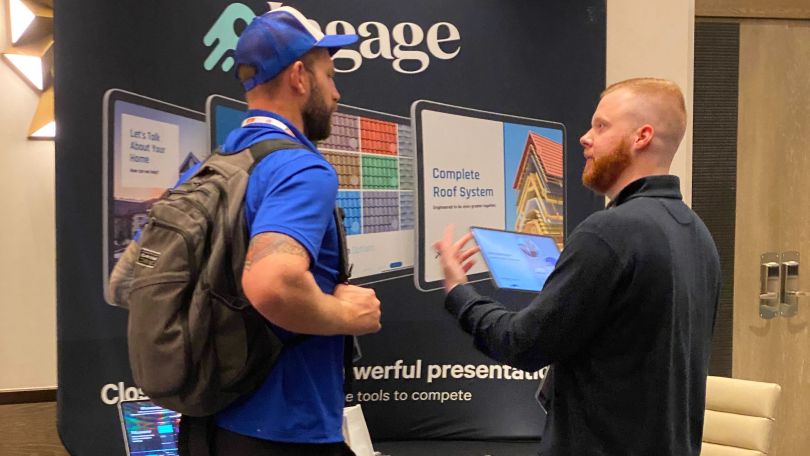There are a lot of jobs that come with health risks.
The industrial fishing industry is cited by many as having the most fatalities of any profession. Lung disease is now known to be an occupational hazard of farming. Pilots and flight engineers often work extremely long hours which make them prone to overexertion.
There is also a category of jobs that, according to the National Library of Medicine, puts workers at a high risk for things like diabetes, coronary heart disease and even mortality below the age of 45 — jobs that most people wouldn’t expect to correlate with these risks: creatives.
Yes, creatives.
Creatives have a significantly higher rate of burnout than other industries, according to a 2022 study conducted by international ad agency TBWA. While burnout may not compare to the job risks of physically challenging duties like hauling up fishing traps in the North Atlantic, it does lead to equally serious health problems.
Ingage, a tech company that helps salespeople create interactive content, addresses employee burnout across its entire team, creative and otherwise, head on — by taking its people-first culture seriously.
“A people-first focus is very important for design, as this is a field where employees can easily burn out from constantly having to flex their creative muscles every day,” said Presentation Designer Sara Bakowski.
Bakowski shared how Ingage takes care of its designers by proactively managing their workloads and giving them plenty of opportunities to hang out with the team. For her, the frequent off-site meetups throughout the year are especially important to help build rapport on a remote team.
“The meetups are not heavily focused on work stuff, allowing us the time to really just relax and get to know each other,” she added.
“A people-first focus is very important for design, a field where employees can easily burn out from constantly having to flex their creative muscles.”
Demand Generation Specialist Mia Walrod agrees that the in-person time she can spend with her team helps her feel connected.
“It’s our chance to relax and bond, making our remote team feel like one big family,” she said. “This makes our regular webinars and social meetings not just about learning — they’re like catch-ups with friends, keeping our sense of community strong no matter where we are.”
Walrod works in marketing and feels that her team is also well supported with things like workload management and dedicated time for an off-site meetup once a year.
“In fields like marketing and sales, where burnout can be high and continuous creativity and resilience are required, a people-first focus is crucial,” she said.
Ingage makes a point to host weekly scheduled meetings for employees to connect socially, webinars to learn more about industry partners, coaching seminars and other events to help keep the staff inspired and connected.
“Employees at Ingage are highly encouraged to be a part of all the goings-on in the company,” said Bakowski. “I’ve never worked anywhere that valued my opinion on all the ins and outs of the business as much as Ingage does.”
Sales Lead Mike Soss added that the community aspect of Ingage helps employees feel welcome in sharing ideas and working on new concepts together.
“Employees are encouraged to participate in any and all aspects of the company,” said Soss. “We want new ideas to be brought to the table on a consistent basis, and by including the entire team in the input process we are able to constantly improve our platform. Everyone here has a hand in the success of the company, and that resonates across the team.”
Soss noted that the in-person time that Ingage creates is what makes the difference, including such opportunities as sending members of the sales team to conferences and events every month. He added that the emphasis on face-to-face client time plays a big factor in when he can be successful and build new business.
“Sales is a constant uphill and downhill battle,” he said. “Ingage is always providing additional opportunities for the sales team to succeed.”

Communicating the Big Picture
At Ingage, success tends to follow those who align with the company’s values and can communicate clearly to their teammates. Very little work is done in a silo at the company.
“It’s all about giving everyone a seat at the table,” said Walrod. “Think of us as a collaborative hub where every voice matters. We believe that the best ideas come from a melting pot of perspectives — that’s what makes our work environment not just inclusive but also invigorating.”
“Think of us as a collaborative hub where every voice matters — that’s what makes our work environment not just inclusive but also invigorating.”
She continued, “We believe in clear communication about our goals and values, helping everyone to see and be part of the bigger picture.”
To Walrod, this thoughtful approach has created a harmonious and positive work environment.
“The culture at Ingage is a product of intentional cultivation,” she added. “It’s like building a team where each member is not just skilled but also resonates with our core values.”
INGAGE CORE VALUES
- Value Focused: Evaluate the short-term ROI and long-term scalability of all resources spent to drive growth.
- Customer First: Approach all aspects of the business with an eye toward driving lasting value and satisfaction for the customer.
- Problem Solver: Tackle problems strategically and apply critical thinking to create solutions that drive value for the company and the customer.
Bakowski echoed that the uniting factor in the company is a commitment to the same core values.
“I think the culture at Ingage was definitely built deliberately by making sure that the people we hired vibed with the other members on our team and that everyone’s core values aligned,” she said.
Walrod added that during interviews with potential new hires, the team asks questions to help them gauge if the person is a natural fit for Ingage’s values regarding a collaborative and open workplace.
POTENTIAL INTERVIEW QUESTIONS AT INGAGE
Sales Lead Mike Soss shared some of the interview questions that an applicant at Ingage might be asked to see if they are a good culture fit for the company.
- Can you describe a work environment where you thrive the most?
- Tell me about a time when you had to collaborate with a diverse group of individuals.
- How did you ensure effective communication and teamwork?
- How do you handle and adapt to change?
- How do you thrive in a team setting?
- Can you provide an example of a time when you had to adjust to a significant change at work?
- How do you prioritize your workload when faced with multiple tasks or projects with tight deadlines?
“During the hiring process, we assess candidates not only for their skills and experience but also for their alignment with the company’s values,” explained Soss. “Hiring individuals who resonate with the culture can contribute to a more cohesive and positive working environment, and providing transparent communication about the company’s mission, values and goals helps employees understand the bigger picture.”
Leading with Action
When companies promise to “put people first,” oftentimes that idea never makes it off the page and into action that employees can point to as an example. This is not the case at Ingage.
Leaders at Ingage make a point to put the well-being of employees as their first priority. Soss sees this commitment all the time on the sales team.
“Our VP of sales encourages team members to adjust their working hours as needed, allowing them to accommodate personal commitments or preferences,” he explained. “He communicates openly with the team about the importance of balance and emphasizes that taking breaks and maintaining personal well-being is crucial.”
Soss noted that sales leadership will share additional resources, allocate extra assistance to the team or even bring in temporary help to alleviate some of the workload pressure when needed.
Bakowski has also witnessed Ingage leaders putting their commitment to communication into action. She told a story about a communication breakdown on the team a while back. At the time, there were some problems between an employee and a manager. The issue was reported to leadership and, after all of the proper steps had been taken, the problem still wasn’t resolved. Finally, the manager was let go.
“It was really refreshing to see leadership take a problem like this seriously and take concrete steps to do something about it until the problem was actually resolved,” she added.

Walrod also had a story to share about Ingage leaders guiding the team through a difficult time.
“There was this occasion where a cross-departmental project hit a rough patch,” she said. “Our director of marketing exemplified leadership by stepping into bridge gaps, facilitating smooth communication and realigning everyone toward our common goals.”
This kind of communal support contributed to Ingage reaching monumental goals in 2023. The marketing team built campaigns that significantly boosted customer engagement, and the sales team reached their biggest win so far: nearly doubling the company’s year-over-year revenue.
“It was a clear indicator of the effectiveness of our team’s focus and collaborative spirit,” concluded Walrod. “And it was a testament to how a people-centric approach can lead to tangible business outcomes.”








